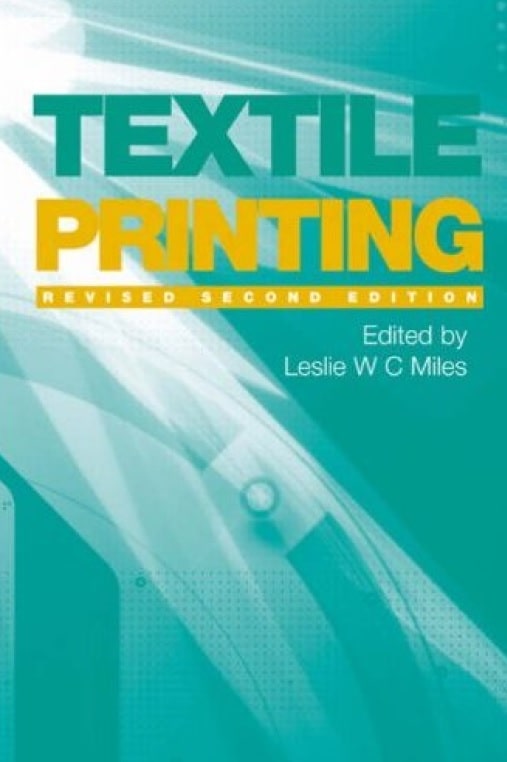
Contents
Contributors v
Prefaces vi
CHAPTER 1 Traditional methods
by Leslie W C Miles 1
1.1 A historical perspective 1
1.2 Surface printing methods 8
1.3 Engraved-roller printing 11
CHAPTER 2 Screen printing
by Christopher J Hawkyard 18
2.1 Introduction 18
2.2 Hand screen and semi-automatic screen printing 20
2.3 Fully automatic flat-screen printing 24
2.4 Rotary-screen printing 31
2.5 Design aspects 37
2.6 Computer-aided design 40
2.7 Screen production 43
2.8 The fundamental mechanism of screen printing 53
2.9 Nontextile applications of screen printing 54
CHAPTER 3 Transfer printing
by Ian D Rattee 58
3.1 Introduction 58
3.2 Sublimation transfer 60
3.3 Melt and film release transfer 87
3.4 Wet transfer printing 95
CHAPTER 4 Carpet and yarn printing
by Timothy L Dawson 99
4.1 Historical development of carpet printing 99
4.2 Yarn printing (space dyeing) 102
4.3 Carpet printing 103
4.4 Printing of carpet tiles 114
4.5 Treatments before and after printing 115
4.6 Physical factors affecting the quality of printed carpets 118
4.7 Selection of dyes and chemicals for printing nylon carpets 126
4.8 Printing of carpets tufted from fibres other than nylon 135
CHAPTER 5 Direct print coloration
by Heinz Gutjahr and Robert R Koch 139
5.1 Introduction 139
5.2 Pigment printing 140
5.3 Cellulosic fibres 153
5.4 Polyester fibres 172
5.5 Cellulose acetate fibres 176
5.6 Acrylic fibres 178
5.7 Polyamide fibres 181
5.8 Protein fibres 183
5.9 Polyester/cellulose fibre blends 187
CHAPTER 6 Discharge, resist and special styles
by Clifford Berry and John G Ferguson 196
6.1 Introduction and definitions 196
6.2 Discharge printing 197
6.3 Application procedures in discharge printing 206
6.4 Resist printing 217
6.5 Special styles 230
CHAPTER 7 The production and properties of printing pastes
by Leslie W C Miles 240
7.1 The requirements 240
7.2 Thickeners 241
7.3 Raw materials: polysaccharides 245
7.4 Viscous emulsions 255
7.5 Viscous foams 257
7.6 Synthetic-polymer thickeners 257
7.7 Print paste rheology 260
7.8 Print paste production 272
7.9 Colour shop organisation 273
CHAPTER 8 Fixation and aftertreatment processes
by Leslie W C Miles 275
8.1 Introduction 275
8.2 Pigment prints 275
8.3 Steamers 276
8.4 Miscellaneous techniques 291
8.5 Washing-off processes 292
8.6 Washing-off equipment 296
CHAPTER 9 The use of digital systems in textile printing
by Timothy L Dawson 301
9.1 Introduction 301
9.2 Image capture and display 304
9.3 Screen making using digital pattern data 308
9.4 Digital control systems in the screen printing industry 311
9.5 Principles of ink-jet printing systems used for textiles 313
9.6 Large-format printing machines for textiles 319
9.7 Ink systems for digital printing 322
9.8 Variables affecting shade reproducibility 326
9.9 Markets for jet-printed textiles 328
9.10 Conclusion
Preface
Textile printing is probably best described as an industrial art, having a long history and an assured future. It has become more dependent on the sciences than it was, but will always be a multidisciplinary activity, requiring more than a knowledge of science and technology.
For those readers with practical, rather than academic, objectives, perhaps looking for answers to specific technical questions, a warning may be necessary. In a short book on such a substantial subject, some generalisations are inevitable but dangerous. Successful printing depends not only on using the appropriate materials and techniques, but also on the coordination of many individuals’ skills. Printing machines have been compared to musical instruments, in that the results obtained depend on who is playing. In any printworks, the difficult patterns are given to the best printers, but even the best printer has to work within the limitations of his equipment and his supporting team.
Before describing current techniques, a brief discussion of the historical development of textile printing may be helpful. The English term ‘printing’ was coined in the 18th century and is derived from a Latin word meaning pressing, the word ‘impression’ being similarly derived. At that time printing was normally achieved by the use of wood blocks, with raised printing surfaces, which required pressure to obtain good contact between the fabric and the colour on the block.
Wood blocks were certainly used for printing illustrations in books at around 1400, and on linen hangings at about the same time. In China, they had been used in the 10th century. Stencil printing of playing cards was established in around 1440, and engraved-copper-plate printing was used in Venice in 1450. Techniques used on paper were naturally tried on fabrics, but often required long processes of trial and error before they could be successfully adapted.
Techniques of resist dyeing, mordant printing and painting had been developed in the East at a much earlier period. Herodotus wrote of the painting of garments in the 5th century BC, a dye that was probably indigo being used. In fact, it was the enormous demand for colourful hand-painted cotton fabrics, imported from India in the 17th century, that stimulated the inventiveness and drive of the European pioneers. By 1842 some 90% of British prints were produced on machines, rather than by hand block and, at about that time, 60% of the cotton fabric produced was printed. The pioneer printers of Europe not only developed the machinery and mastered the art of using suitable thickeners, but were also innovators of the factory system.
